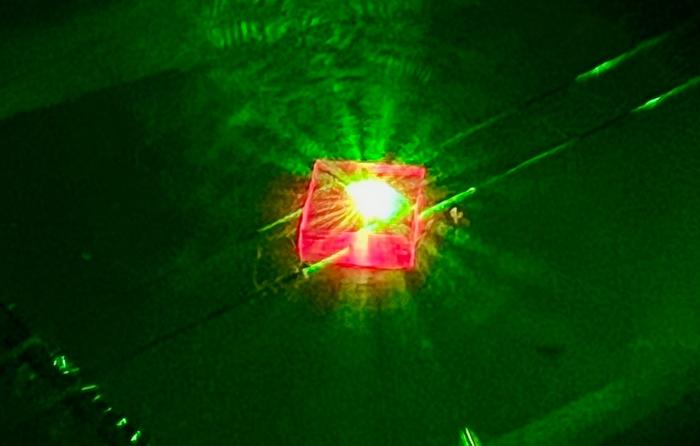In a significant advancement in the field of quantum physics, researchers at Washington University in St. Louis have successfully created a groundbreaking new phase of matter known as a “time quasicrystal.” This experimental marvel builds upon the concept of time crystals, which have astonished scientists since their first realization in 2016. Time quasicrystals represent a new frontier in the manipulation of time and periodicity at the quantum level.
Traditional crystals, such as diamonds and quartz, rely on the repetitive arrangement of atoms across spatial dimensions. In contrast, time crystals and particularly time quasicrystals exhibit energy states that oscillate perpetually in time. The phenomenon challenges and expands our understanding of thermodynamics and periodic phenomena, as time quasicrystals demonstrate a capacity for sustained motion without the classic influences that would typically result in decay or energy loss. This characteristic raises intriguing questions about their potential applications in the realm of quantum technology.
At the core of this research is the idea of stability and sustainability in quantum systems. The researchers highlighted that, theoretically, a time crystal should continue to oscillate indefinitely. While practical observations showed that their time quasicrystal sustained hundreds of cycles before degradation, this fragility does not diminish its significance. Instead, it represents a step closer to harnessing the properties of time crystals for future technological innovations.
The researchers note that the concept of time quasicrystals transcends mere scientific curiosity; they have the potential for real-world applications. For instance, these structures could serve as incredibly stable sensors, responding to quantum forces without the need for recharging. This aligns with current endeavors to develop precise instruments in areas such as quantum computing and information technology. By maintaining consistent oscillations, time quasicrystals could pave the way for breakthroughs in creating more accurate and reliable timekeeping technologies.
Exploring the differences between traditional time crystals and this new class of time quasicrystals illuminates their unique properties. In traditional time crystals, the arrangement is uniform regarding time, akin to a consistent beat of a clock. Time quasicrystals, however, break away from this pattern, allowing for a mixture of frequencies that resemble complex chords rather than a single tonal note. This intricate behavior arises from the non-periodic arrangements that characterize quasicrystals, suggesting a deeper complexity in the dance of particles at the quantum level.
The experimental methodology employed by the WashU team demonstrates innovative engineering within the realm of nanostructures. By utilizing precise microwave pulses and bombarding a diamond with nitrogen, the researchers orchestrated a controlled environment for their quasicrystal. This fractional approach to structure formation, where individual quantum events can be manipulated, represents a significant leap in our ability to craft desired materials at the atomic level.
As quantum researchers delve deeper into the potential of time and quasicrystal structures, the implications for future technologies become increasingly fascinating. Imagine a world where quantum memory systems can store vast amounts of information and operate with minimal energy consumption. The prospect of time quasicrystals functioning as a type of quantum RAM introduces revolutionary possibilities for computer science. The journey to unlocking these advancements may still be in early stages, but the groundwork laid by Murch, Zu, and their team is undeniably promising.
For quantum physicists, the creation of the time quasicrystal is not merely an academic milestone; it challenges preconceived notions of how matter behaves under quantum conditions. As we increase our understanding of such phenomena, the potential for practical applications emerges, which could transform various fields, from materials science to information technology.
The Washington University research team stands at the forefront of this remarkable new era, generating intrigue and excitement in the scientific community and beyond. With their findings published in the esteemed journal “Physical Review X,” they are now inviting further exploration and investigation into the uncharted territories of time manipulation and quantum phenomena.
What lies ahead in the realm of time quasicrystals remains a matter of speculation. However, the implications on fundamental aspects of physics—such as entropy, energy conservation, and quantum coherence—could alter not only theoretical frameworks but also serve as practical solutions for future technology challenges. As researchers continue to unpack these layers of complexity, the fabric of our understanding of time and matter may undergo profound transformation.
Indeed, the creation of time quasicrystals signifies a pivotal moment in quantum research, pushing the boundaries of what is possible. As we venture into this exciting frontier, the synergy between academia and practical innovation will undoubtedly shape the next generation of technologies, offering glimpses of a future interconnected with the principles of quantum mechanics.
By bridging the gap between theory and application, the WashU team opens doors to a realm where time, usually perceived as linear and rigid, takes on new dimensions of possibility. This breakthrough might not only change our scientific paradigms but could also redefine the fundamental structures of our technological landscape, paving the way for future researchers to explore the myriad applications this novel phase of matter could unlock.
Subject of Research: Time Quasicrystals
Article Title: Experimental Realization of Discrete Time Quasicrystals
News Publication Date: 12-Mar-2025
Web References: Physical Review X DOI
References: Chon Zu, Guanghui He et al., “Experimental Realization of Discrete Time Quasicrystals,” Physical Review X.
Image Credits: Chong Zu laboratory, Washington University in St. Louis
Keywords
Time Quasicrystal, Quantum Physics, Quantum Technology, Time Crystals, Washington University, Nanostructures, Quantum Mechanics.
Tags: advanced materials in quantum scienceChong Zu scientific contributionsimplications for thermodynamicsinnovative diamond structure in experimentsKater Murch quantum researchmanipulation of time in physicsnew phase of matter discoveryoscillation of quantum statesperiodicity at quantum levelquantum physics breakthroughstime crystals evolutiontime quasicrystal research





